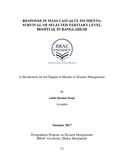Response in mass casualty incidents: survival of selected tertiary level hospital in Bangladesh

View/
Date
2017-07Publisher
BRAC UniversityAuthor
Munir, AKM MashiulMetadata
Show full item recordAbstract
An effective and immediate response from hospital personnel is critical to meet the needs
of affected populations at the time of an disaster. Hospitals need to develop, practice and
continuously update an effective disaster/emergency medical response plan.
Communities and impacted regions cannot depend on immediate medical and
humanitarian aid from other outside sources to meet medical care needs during the first
three to five days following a mass casualty incident. How hospitals in disaster-prone
countries like Bangladesh can improve their medical response is discussed.
To find out the resilience of a tertiary level hospital in Bangladesh to combat mass
casualty incidents, Kurmitola General Hospital was selected and study was carried out.
This study was a cross-sectional questionnaire survey. The administrator, engineers and
in charge of the Emergency & Casualty department were interviewed. The hospital was
visited to verify the selected questionnaire response by a checklist. Among all the tertiary
level hospitals “Kurmitola General Hospital” was selected. It is the most recently
constructed tertiary level general hospital in Bangladesh. So it is expected that disaster
survival and disaster support elements and structures are well formulated in this hospital.
This study was conducted from January 2017 to September 2017. The WHO guideline
was followed to find out resilience of Kurmitola General Hospital.
Hospital Safety Index (HSI) for this hospital was included with 162 items, which
included structural, non-structural and functional capacity. Hospital safety was classified
to three safety classes: low (≤34.0), average (34.01–66.0) and high (>66.0). Structural
safety of this hospital was 100%, nonstructural safety was rated as 78%. But functional
safety which included the managerial aspects was 37% only. Which demands more
emphasis to be given on hospital disaster planning, training of personnel and coordination
with other stakeholders.
Same type of survey for all the tertiary level hospitals of Bangladesh and forwarding a
consolidated report to the competent authority for further planning is recommended.
